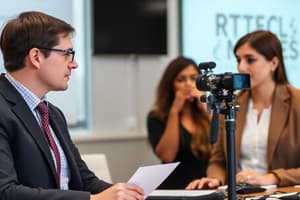Podcast
Questions and Answers
What is the primary objective of public information in public relations?
What is the primary objective of public information in public relations?
- To provide biased information to generate interest
- To analyze and criticize public sentiment
- To share unbiased and correct information with the public (correct)
- To persuade the public towards a specific view
Which of the following best describes agenda-setting theory?
Which of the following best describes agenda-setting theory?
- A technique to enhance public trust in media
- The manipulation of public awareness and concern by news media (correct)
- A method to eliminate certain topics from public discourse
- A strategy for ensuring impartiality in reporting
Who were the primary developers of the Agenda Setting Theory?
Who were the primary developers of the Agenda Setting Theory?
- Walter Lippmann and Joseph Pulitzer
- Maxwell McCombs and Donald Shaw (correct)
- Edward Bernays and Ivy Lee
- Marshall McLuhan and Noam Chomsky
In political public relations, which practices are typically used to convey public information?
In political public relations, which practices are typically used to convey public information?
What does the first level of agenda-setting primarily focus on?
What does the first level of agenda-setting primarily focus on?
How does the study of agenda-setting suggest media influences its audience?
How does the study of agenda-setting suggest media influences its audience?
Which of the following is NOT a function of public information in public relations?
Which of the following is NOT a function of public information in public relations?
In terms of political communication, what critical function does public relations serve?
In terms of political communication, what critical function does public relations serve?
What is the first stage of the innovation decision process?
What is the first stage of the innovation decision process?
Which adopter category is characterized as risk-takers and requires the shortest adoption period?
Which adopter category is characterized as risk-takers and requires the shortest adoption period?
What best describes the relative advantage of an innovation?
What best describes the relative advantage of an innovation?
Which category is most likely to be opinion leaders in the innovation adoption process?
Which category is most likely to be opinion leaders in the innovation adoption process?
How does social structure influence the diffusion process?
How does social structure influence the diffusion process?
Which characteristic of innovation refers to its perceived difficulty of understanding and use?
Which characteristic of innovation refers to its perceived difficulty of understanding and use?
Which adopter category is often skeptical and views technology as a hindrance?
Which adopter category is often skeptical and views technology as a hindrance?
What characteristic of innovation assesses its alignment with the existing values of potential adopters?
What characteristic of innovation assesses its alignment with the existing values of potential adopters?
What does trialability refer to in the context of innovation?
What does trialability refer to in the context of innovation?
Which type of innovation decision is characterized by individual choices made independently?
Which type of innovation decision is characterized by individual choices made independently?
In framing theory, what influences how people process information?
In framing theory, what influences how people process information?
What are expectations in the context of framing theory resistant to?
What are expectations in the context of framing theory resistant to?
What does the term 'observability' refer to?
What does the term 'observability' refer to?
Which type of innovation decision involves choices made by a few individuals with power or expertise?
Which type of innovation decision involves choices made by a few individuals with power or expertise?
According to Goffman, what are social cues used for?
According to Goffman, what are social cues used for?
What is a contingent innovation decision?
What is a contingent innovation decision?
What is the primary role of media relations in an organization?
What is the primary role of media relations in an organization?
Which of the following is NOT one of the 5 C's of effective media relations?
Which of the following is NOT one of the 5 C's of effective media relations?
What is meant by 'downshifting' in the context of reframing situations?
What is meant by 'downshifting' in the context of reframing situations?
Which of the following is NOT one of the five popular ways of framing news stories identified by Entman?
Which of the following is NOT one of the five popular ways of framing news stories identified by Entman?
What is the significance of involving the media in the story-telling process?
What is the significance of involving the media in the story-telling process?
What type of framing focuses on mental representation and interpretation of reality?
What type of framing focuses on mental representation and interpretation of reality?
Who is responsible for ensuring that press releases are timely and media lists are updated?
Who is responsible for ensuring that press releases are timely and media lists are updated?
How does 'Human Interest/Personalisation' framing influence news stories?
How does 'Human Interest/Personalisation' framing influence news stories?
What quality must a writer have in the context of media relations?
What quality must a writer have in the context of media relations?
Which of the following best describes media relations as an art?
Which of the following best describes media relations as an art?
What does the 'Consequence' framing typically highlight?
What does the 'Consequence' framing typically highlight?
In the context of media framing, what does the 'Responsibility' framing typically convey?
In the context of media framing, what does the 'Responsibility' framing typically convey?
What is the role of the 'target audience' in the media relations tripod?
What is the role of the 'target audience' in the media relations tripod?
What distinguishes the science aspect of media relations?
What distinguishes the science aspect of media relations?
Which of the following best describes 'Generic framing'?
Which of the following best describes 'Generic framing'?
What role do sources, reporters, and editors play in the creation of frames for stories?
What role do sources, reporters, and editors play in the creation of frames for stories?
Flashcards are hidden until you start studying
Study Notes
Public Information
- Public relations practitioners in this model resemble journalists, sharing objective information about their organization.
- Focus: Disseminating information, not persuasion.
- Public relations experts must provide accurate and unbiased information about the organization to the public.
- Public relations practitioners in this model are viewed as conduits of information.
Agenda Setting
- Agenda-setting theory posits that the media influences public awareness and concern about important issues.
- Nations with more political power receive higher media exposure.
- The theory emphasizes the media's ability to establish a hierarchy of news prominence.
- Agenda-setting theory suggests that the media can influence the audience's perceptions of what is important.
Innovation Adoption Process
- The Innovation Adoption Process assesses how new ideas and technologies are adopted by a social system.
- Innovation adopter categories: Innovators, early adopters, early majority, late majority, and laggards.
- Social system: The group of people involved in the adoption process, such as employees of an institution, a neighborhood, or a nation.
- Innovation decision process: Knowledge, persuasion, decision, implementation, and confirmation.
- Innovativeness: The degree to which an individual is early in adopting new ideas compared to others in the system.
Framing
- How information is presented to the audience influences their understanding and decisions – this is called framing.
- Sociological Framing: Focuses on the process of news production and the news industry.
- Psychological Framing: Analyses how the audience interprets and processes information based on mental categories.
- Frames of expectation: These are derived from past experiences and media messages, and can be resistant to change.
- Strong emotions: Frames can evoke strong emotions like hate, fear, or love.
- Upshift and Downshift: Refers to the reframing of a situation to make it seem more or less serious.
Developing a Media Relations Strategy
- Media Relations involves strategically using media to tell an organization's story and reach a wider audience.
- Key elements of media relations: the organization (sender), the media (transmitter), and the target audience (receiver).
- Art of Media Relations: Involves creativity in engaging media operators and audiences.
- Science of Media Relations: Requires systematic planning, measurement, and analysis.
- The 5 C's of Effective Media Relations: Credibility, Candor, Clarity, Compassion, and Commitment.
- Media team: A coordinator who is personable and articulate, a writer with strong writing and editing skills.
Studying That Suits You
Use AI to generate personalized quizzes and flashcards to suit your learning preferences.




